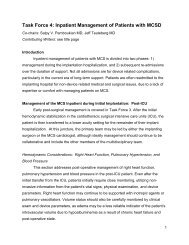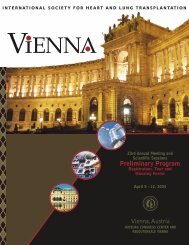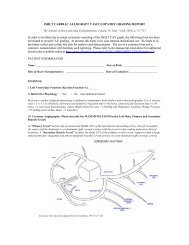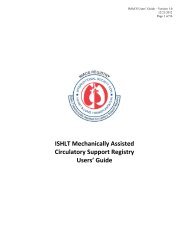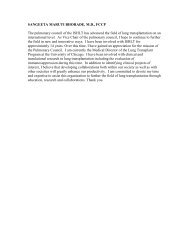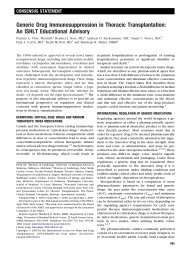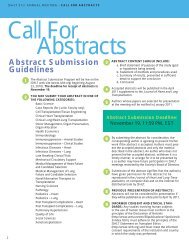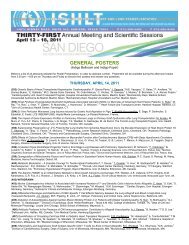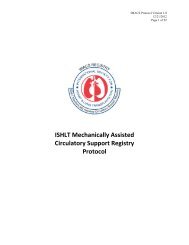Guidelines for the care of heart transplant recipients
Guidelines for the care of heart transplant recipients
Guidelines for the care of heart transplant recipients
You also want an ePaper? Increase the reach of your titles
YUMPU automatically turns print PDFs into web optimized ePapers that Google loves.
Costanzo et al.<br />
<strong>Guidelines</strong> <strong>for</strong> Heart Transplant Care<br />
927<br />
Table 7 Drugs That Affect <strong>the</strong> Levels <strong>of</strong> Tacrolimus,<br />
Cyclosporine, Sirolimus, and Everolimus<br />
Decrease immunosuppression<br />
levels<br />
Anti-epileptics<br />
Carbamazepine<br />
Fosphenytoin<br />
Phenobarbital<br />
Phenytoin<br />
Anti-microbials<br />
Casp<strong>of</strong>ungin<br />
Nafcillin<br />
Rifabutin<br />
Rifampin<br />
Rifapentine<br />
Anti-retroviral Therapy<br />
Efavirenz<br />
Etravirine<br />
Nevirapine<br />
O<strong>the</strong>rs<br />
Antacids containing<br />
magnesium, calcium, or<br />
aluminum (tacrolimus only)<br />
Deferasirox<br />
Modafinil<br />
St. John’s wort<br />
Thalidomide<br />
Ticlopidine<br />
Troglitazone<br />
Increase immunosuppression<br />
levels<br />
Anti-microbials<br />
Clarithromycin<br />
Erythromycin<br />
Metronidazole and tinidazole<br />
Quinupristin/dalfopristin<br />
Lev<strong>of</strong>loxacin<br />
Anti-fungals<br />
Clotrimazole<br />
Itraconazole<br />
Ketoconazole<br />
Fluconazole<br />
Posaconazole<br />
Voriconazole<br />
Anti-retroviral <strong>the</strong>rapy<br />
Protease inhibitors (general)<br />
Amprenavir<br />
Atazanavir<br />
Darunavir<br />
Fosamprenavir<br />
Indinavir<br />
Nelfinavir<br />
Ritonavir<br />
Saquinavir<br />
Tipranavir<br />
Cardiovascular<br />
Amiodarone<br />
Diltiazem<br />
Verapamil<br />
Nutraceuticals<br />
Bitter orange<br />
Grapefruit juice<br />
O<strong>the</strong>rs<br />
Rilonacept<br />
Theophylline<br />
Cimetidine<br />
Fluvoxamine<br />
Glipizide<br />
Glyburide<br />
Imatinib<br />
Nefazodone<br />
Recommendations <strong>for</strong> <strong>the</strong> Monitoring <strong>of</strong> Immunosuppressive<br />
Drug Levels 136–149 :<br />
(See Table 7)<br />
Class I:<br />
1. The use <strong>of</strong> <strong>the</strong> microemulsion <strong>for</strong>mulation <strong>of</strong> CYA is<br />
recommended because it is associated with more favorable<br />
pharmacokinetic features compared with <strong>the</strong> oilbased<br />
compound.<br />
Class IIa:<br />
Level <strong>of</strong> Evidence: B.<br />
1. At present, 2-hour post-dose (C2) levels should not replace<br />
12-hour trough (C0) concentrations <strong>for</strong> routine<br />
monitoring <strong>of</strong> CYA exposure in most patients, but may<br />
be useful in selected patients in whom a better characterization<br />
<strong>of</strong> <strong>the</strong> pharmacokinetic pr<strong>of</strong>ile <strong>of</strong> CYA is desired.<br />
Level <strong>of</strong> Evidence: B.<br />
2. Measurement <strong>of</strong> 12-hour trough CYA concentration is<br />
<strong>the</strong> recommended <strong>for</strong>m <strong>of</strong> <strong>the</strong>rapeutic drug monitoring<br />
<strong>for</strong> routine clinical use. The target levels are dependent<br />
on <strong>the</strong> method used (high-per<strong>for</strong>mance liquid chromatography<br />
[HPLC] vs enzyme multiplied immunoassay<br />
technique [EMIT] vs cloned enzyme donor immunoassay<br />
method [CEDIA]), concomitant immunosuppression,<br />
toxicity risks, and time after HT. In general, when<br />
used in conjunction with azathioprine (AZA) or a mycophenolic<br />
acid (MPA) preparation, <strong>the</strong> average CYA<br />
trough concentration target using <strong>the</strong> Abbot TDX assay<br />
(or equivalent) is 325 ng/ml (range, 275–375 ng/ml) <strong>for</strong><br />
<strong>the</strong> first 6 post-operative weeks, 275 ng/ml (range 200–<br />
350 ng/ml) <strong>for</strong> Weeks 6 to 12, 225 ng/ml (range 150–<br />
300 ng/mL) <strong>for</strong> Month 3 to Month 6, and 200 ng/ml<br />
(range 150–250 ng/mL) from Month 6 onwards.<br />
Level <strong>of</strong> Evidence: C.<br />
3. At present, CYA trough concentration targets when<br />
CYA is used in combination with proliferation signal<br />
inhibitor (PSI; mammalian target <strong>of</strong> rapamycin [mTOR]<br />
inhibitors) agents have not been adequately determined.<br />
Level <strong>of</strong> Evidence: C.<br />
4. Measurement <strong>of</strong> 12-hour trough concentration <strong>for</strong> twicedaily<br />
TAC and a 24-hour trough concentration <strong>for</strong> oncedaily<br />
TAC is <strong>the</strong> recommended drug monitoring method<br />
<strong>for</strong> routine clinical use. The <strong>the</strong>rapeutic range <strong>of</strong> TAC<br />
levels varies depending on concomitant drugs, toxicity<br />
concerns, and time after HT. In general, when used in<br />
conjunction with AZA or a MPA preparation, TAC<br />
trough concentration targets range between 10 and 15<br />
ng/ml during <strong>the</strong> early post-operative period (Days<br />
0–60), between 8 and 12 ng/ml <strong>for</strong> <strong>the</strong> next 3 to 6<br />
months, and between 5 and 10 ng/ml in stable patients 6<br />
months after HT.<br />
Level <strong>of</strong> Evidence: C.<br />
5. At this time, target <strong>the</strong>rapeutic TAC trough concentrations<br />
when TAC is used in combination with PSI (mTOR<br />
inhibitors) agents have not been adequately determined.<br />
Level <strong>of</strong> Evidence: C.<br />
6. Therapeutic drug monitoring <strong>for</strong> PSIs using trough concentration<br />
levels is recommended <strong>for</strong> sirolimus (SRL)<br />
and everolimus (EVL). Levels should be measured at<br />
least 5 days after adjustment <strong>of</strong> <strong>the</strong> dose, when a new<br />
steady state is achieved. When used in combination with<br />
CYA, <strong>the</strong> optimal trough target level <strong>for</strong> EVL is between<br />
3 and 8 ng/ml. The corresponding optimal trough level<br />
<strong>for</strong> SRL is 4 to 12 ng/ml.<br />
Level <strong>of</strong> Evidence: B.



